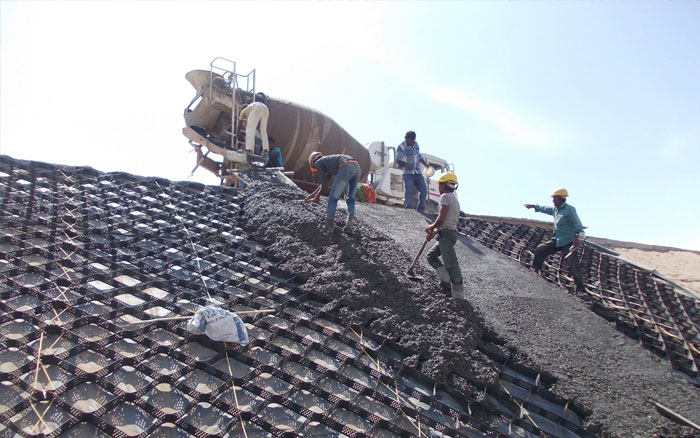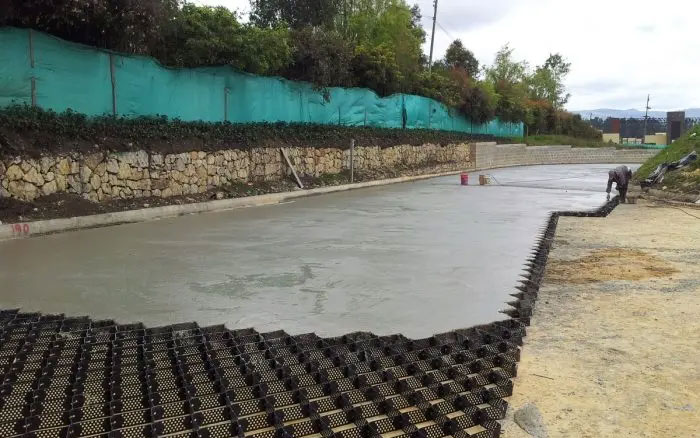
Road construction is a complex process that requires careful planning and execution to ensure a safe and durable road infrastructure. Geocells, three-dimensional cellular confinement systems, are one of the materials used in building a road that offer several advantages and are gaining popularity in the industry.
What is the meaning of road construction?
Road construction refers to the process of building, repairing, or expanding roads, highways, and other transportation infrastructures that are used for vehicular or pedestrian traffic. The purpose of road making is to improve transportation networks and make them more efficient, safe, and convenient for people and goods to move from one place to another.
Road construction typically involves a range of activities such as surveying, designing, planning, grading, excavating, paving, and installing drainage systems, traffic signals, and other safety features. The construction process may also include the use of heavy equipment such as bulldozers, graders, excavators, and asphalt pavers.
Road building projects can vary in size and complexity, from small repairs and maintenance work to large-scale projects such as building new highways or bridges. The construction of roads is essential for economic development and mobility, allowing people to commute to work, transport goods, and access essential services such as healthcare and education.
The material used in road construction
There are several materials used in road construction, depending on the type and purpose of the road, the climate and weather conditions, and the availability of materials in the region. Some of the most common materials include:
- Asphalt: Asphalt is a mixture of aggregates (crushed stone, gravel, sand) and bitumen (a petroleum-based binder).
- Concrete: Concrete is a mixture of cement, water, and aggregates, such as sand, gravel, or crushed stone.
- Gravel: Gravel is a loose aggregation of small stones, which is often used as a base layer for roads and highways.
- Crushed stone: Crushed stone is a type of construction aggregate that is made by crushing large rocks into smaller pieces.
- Soil stabilization materials: Soil stabilization materials such as lime, cement, and fly ash are used to improve the strength and stability of soil on which roads are constructed.
- Geosynthetics: Geosynthetics, such as geotextiles, geogrids, and geocells, are synthetic materials used to reinforce the soil and prevent erosion on slopes and embankments.
What are the four layers of road construction?
The four layers of road construction are:
- Subgrade: The subgrade is the natural soil or rock layer on which the road is built. It provides the foundation for the road and should be able to support the weight of the road, the traffic, and any other structures on or near the road.
- Subbase: The subbase is a layer of material placed on top of the subgrade. It provides additional strength and support to the road and helps to distribute the load of traffic more evenly.
- Base: The base is a layer of material placed on top of the subbase. It provides a stable and durable surface for the road and helps to resist deformation and cracking.
- Surface: The surface is the top layer of the road and is the part that comes into direct contact with vehicle tires. It should be smooth, durable, and skid-resistant to provide good traction for vehicles.
The stages involved in the road building
The stages involved in road building typically include the following:
- Planning and design: This stage involves identifying the need for a new road, determining the location and alignment, and developing a detailed design for the road. The design process includes surveying the site, conducting soil tests, and developing plans and specifications for the road construction.
- Site preparation: Site preparation involves clearing the land where the road will be built, removing trees, vegetation, and other obstacles. The site is then graded and leveled to provide a stable foundation for the road.
- Construction of subgrade and drainage: The subgrade is the foundation for the road, and it is built by compacting the soil and adding layers of gravel or crushed stone. Drainage systems, such as culverts or ditches, are also installed to manage surface water runoff.
- Construction of subbase and base: The subbase and base layers are constructed by adding layers of crushed stone or gravel and compacting them to provide a stable and durable surface for the road.
- Paving: Once the subbase and base layers are in place, the road is paved with asphalt concrete or concrete. The paving process involves laying the surface layer, compacting it, and finishing it to provide a smooth and durable surface.
- Marking and signage: After the road surface is complete, it is marked with traffic lines and symbols, and traffic signs are installed to guide drivers and ensure safety.
- Maintenance: Regular maintenance is necessary to keep the road in good condition and prevent deterioration. Maintenance activities include patching potholes, repairing cracks, and resurfacing the road as needed.
The techniques used in the construction of roads
There are several techniques used in the construction of roads, depending on the type of road, the terrain, and the materials used. Here are some of the common techniques used in road construction:
- Earthworks: This involves excavating and moving soil and rock to create the subgrade and shape the road. Earthworks may also be used to create embankments, cuttings, and drainage systems.
- Grading: Grading involves leveling the surface of the road to provide a smooth and even surface for the subbase and base layers.
- Compaction: Compaction is the process of compressing soil, gravel, or other materials to increase their density and stability. Compaction is critical for creating a stable and durable road foundation.
- Pavement: Pavement is the surface layer of the road and can be made of asphalt, concrete, or other materials. Pavement is designed to provide a smooth, skid-resistant surface for vehicles and pedestrians.
- Drainage: Proper drainage is critical for maintaining the stability and durability of the road. Drainage systems, such as culverts, ditches, and stormwater management systems, are installed to manage surface water runoff.
- Asphalt paving: Asphalt paving involves laying and compacting layers of asphalt to create the surface layer of the road. This process requires specialized equipment, including asphalt pavers and rollers, to ensure proper compaction and smoothness.
- Concrete paving: Concrete paving involves pouring and finishing concrete to create the surface layer of the road. This process requires specialized equipment and skilled workers to ensure proper curing and finishing.
- Surface treatments: Surface treatments, such as seal coats or chip seals, are applied to the road surface to improve traction, durability, and appearance.
How are geocells used in road construction?
Geocells are used in road construction to improve the stability and load-bearing capacity of the subgrade and reduce soil erosion. They are easy to install and can be customized to fit the specific requirements of the road construction project. They are also durable and resistant to weathering, making them ideal for use in harsh environments.
Here are some of the ways geocells are used in road construction:
- Soil stabilization: Geocells can be used to stabilize the soil in the subgrade and prevent soil erosion. The cells are filled with soil, gravel, or other materials, which helps to distribute the load of the road evenly and prevent differential settlement.
- Slope protection: They can be used to stabilize slopes and prevent soil erosion on embankments. The cells are filled with soil or vegetation, which helps to stabilize the slope and prevent erosion.
- Retaining walls: Geocells can be used to construct retaining walls along the sides of roads. The cells are stacked on top of each other to create a stable structure that can support the weight of the road and prevent soil erosion.
- Drainage: They can be used to construct drainage systems, such as culverts or ditches, to manage surface water runoff and prevent erosion.
Advantages of geocells in road construction
Geocells offer several advantages in road construction, including:
- Improved stability: Geocells provide a stable platform for the road by reinforcing the subgrade and distributing the load of the road more evenly. This helps to prevent differential settlement, rutting, and other types of pavement distress.
- Increased load-bearing capacity: They can increase the load-bearing capacity of the road by up to 10 times, allowing it to support heavier vehicles and higher traffic volumes.
- Reduced construction time and cost: Geocells are easy to install and can reduce the amount of excavation, fill, and grading required for the road construction. This can help to reduce construction time and cost, especially in areas with poor soil conditions.
- Environmental benefits: They can be filled with locally available materials, such as soil or gravel, reducing the need for imported materials and transportation. This can help to reduce the carbon footprint of the road construction and minimize environmental impact.
- Durability: Geocells are made of high-density polyethylene (HDPE) or other materials that are resistant to weathering and degradation. This makes them durable and long-lasting, reducing the need for frequent maintenance and repairs.
Disadvantages of geocells in road construction
While geocells offer several advantages in road construction, there are also some potential disadvantages to consider, including:
- Initial cost: The cost of geocells can be higher than traditional materials such as crushed stone or gravel. However, this cost may be offset by the reduced need for excavation, fill, and grading, as well as the longer lifespan of the road.
- Installation complexity: Geocell installation requires specialized equipment and skilled labor, which can increase the complexity and cost of the road construction.
- Maintenance requirements: While they are durable and long-lasting, they may require occasional maintenance to ensure proper performance. For example, the cells may need to be refilled or replaced if they become damaged or degraded over time.
- Limited availability: They may not be readily available in all areas, which can limit their use in road construction projects.
- Limited research: While geocells have been used in road construction for several decades, there is still limited research on their long-term performance and durability.
Conclusion
Road construction involves multiple stages and materials. Overall, geocells offer a cost-effective and sustainable solution for building a road projects, but their use should be carefully evaluated against other materials and techniques.







